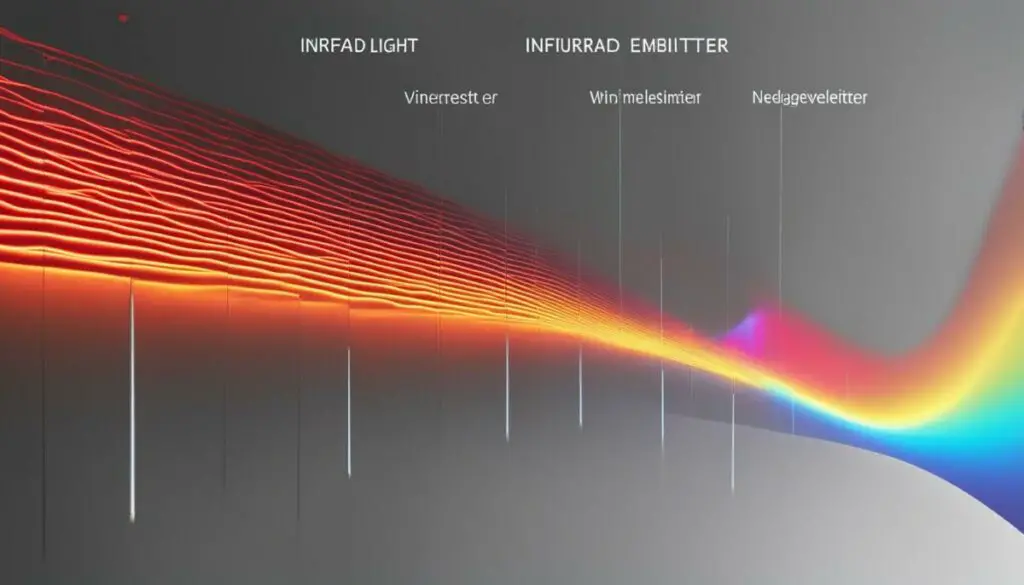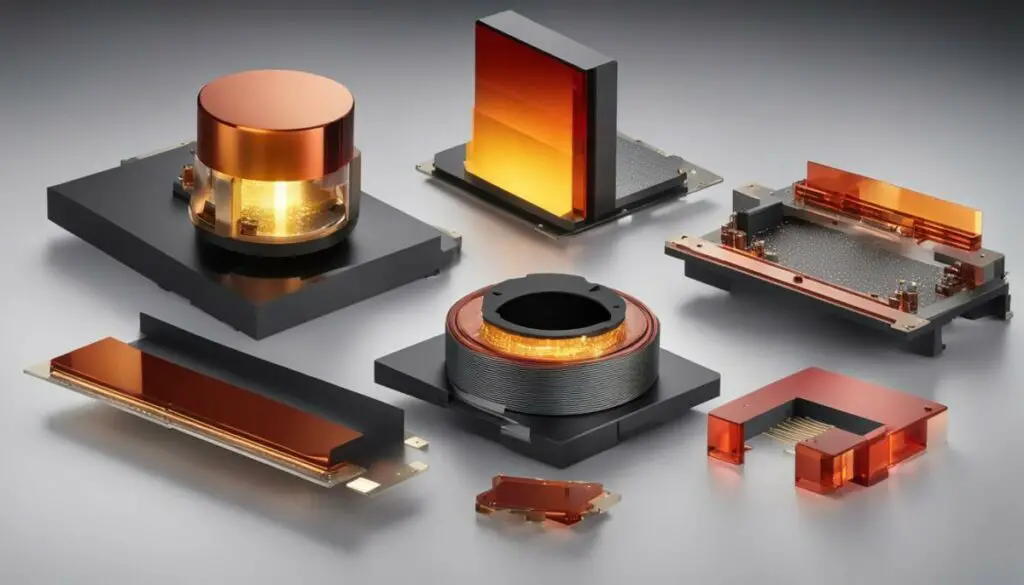Last Updated on 6 months by Francis
Are you familiar with infrared emitters? Maybe you’ve used them without even knowing it. Infrared emitters are essential components in many everyday devices, such as remote controls and security systems. In this article, we will provide you with a comprehensive understanding of what an infrared emitter is and the technology behind it.
An infrared emitter is a device that emits infrared radiation. It is used in a wide range of applications, from heating and drying to remote sensing and communication. Infrared radiation is a type of electromagnetic radiation that has a longer wavelength than visible light but shorter than radio waves. Infrared emitters convert electrical energy into infrared radiation, which can then be used for various purposes.
Infrared emitters come in different forms, including incandescent, LED, and laser-based emitters. Each type has its own advantages and disadvantages, depending on the application requirements. For example, incandescent emitters are often used for heating and drying applications, while LED and laser-based emitters are more suitable for communication and sensing applications.
Contents
Key Takeaways
- An infrared emitter is a device that emits infrared radiation.
- Infrared radiation is a type of electromagnetic radiation that has a longer wavelength than visible light but shorter than radio waves.
- Infrared emitters come in different forms, including incandescent, LED, and laser-based emitters.
Understanding Infrared Emitter Technology

When it comes to understanding how infrared emitters work, it’s important to first grasp the different types available in the market. Infrared emitters are broadly categorized into three types:
- Incandescent emitters
- LED emitters
- Laser-based emitters
Incandescent emitters generate infrared radiation by heating up a filament until it glows. The emitted wavelengths range from infrared to ultraviolet. LED emitters, on the other hand, produce radiation by using a semiconductor material that emits light when an electric current passes through it. Lastly, laser-based emitters are the most intense infrared emitters and utilize a laser to generate radiation.
Now that we know the types of infrared emitters, let’s explore how they work. All infrared emitters have one thing in common – they emit electromagnetic radiation with a wavelength between 780 to 1,000,000 nm, which is invisible to the naked eye. When this radiation hits an object, it either gets absorbed, transmitted, or reflected. The type and amount of radiation that gets absorbed, transmitted, or reflected depend on the characteristics of the object, like its surface, texture, and color.
For instance, if you have ever used a TV remote, you know how it works – when you press a button, the remote’s LED emitter sends a beam of infrared radiation towards your TV, which has a receiver that picks up and interprets the signal. This signal is then converted into an electrical impulse that commands the TV to perform the desired action.
Types of Infrared Emitters
Let’s take a closer look at the different types of infrared emitters:
| Type of Infrared Emitter | Advantages | Disadvantages |
|---|---|---|
| Incandescent Emitters | High power output, broad wavelength range | Short lifespan, low efficiency |
| LED Emitters | Long lifespan, high efficiency, low power consumption | Low power output, narrow wavelength range |
| Laser-based Emitters | High power output, narrow beam angle, precise control | Expensive, safety concerns, complex design |
Each type of infrared emitter has its own advantages and disadvantages, making them suitable for different applications. For instance, incandescent emitters are commonly used in industrial heating applications, while LED emitters are found in consumer electronics and automotive lighting systems. Laser-based emitters, on the other hand, are used in precision manufacturing and scientific research.
Now that we have explored the types and workings of infrared emitters, let’s move on to their key characteristics in the next section.
Characteristics of Infrared Emitters

Understanding the characteristics of an infrared emitter is crucial for selecting the right emitter for a specific application. Here are some key features to consider:
| Wavelength Range | The wavelength range of infrared emitters can vary widely, from a few micrometers to several hundred micrometers. This range determines the type of material that an emitter can detect and the distance at which it can operate. |
|---|---|
| Power Output | The power output of an infrared emitter is measured in watts or milliwatts and determines its range and effectiveness. High-power emitters are suitable for long-distance applications, whereas low-power emitters are ideal for short-range applications. |
| Beam Angle | The beam angle of an infrared emitter determines the area of coverage. Emitters with a narrow beam angle are suitable for long-distance applications, whereas emitters with a wide beam angle are ideal for short-range applications. |
| Response Time | The response time of an infrared emitter refers to the time taken to switch on and off. It determines the emitter’s ability to respond to rapidly changing signals. |
| Efficiency | The efficiency of an infrared emitter determines its ability to convert electrical power to infrared radiation. Higher efficiency emitters produce more radiation for the same input power. |
| Spectral Response | The spectral response of an infrared emitter determines the range of wavelengths to which it is sensitive. This characteristic is critical for applications that require the detection of specific materials or gases. |
It’s worth noting that the characteristics of infrared emitters can vary widely based on the emitter’s technology and application. Therefore, it is essential to consult with the manufacturer’s specifications and application requirements before making a purchase.
Exploring Infrared Emitter Applications

Infrared emitters have a diverse range of applications across various industries. Here are some examples of how infrared emitters are used:
| Application | Description |
|---|---|
| Remote Controls | Infrared emitters are commonly used in remote controls for televisions, DVD players, and other electronic devices. They send signals to the receiver, allowing users to control the device from a distance. |
| Thermal Imaging | Infrared emitters are used in thermal imaging systems for temperature sensing and analysis. They detect the infrared radiation emitted by objects and create an image based on the temperature differences. |
| Communication Systems | Infrared emitters are used in optical communication systems for data transmission. They send signals via infrared radiation to a receiver, which decodes and interprets the data. |
| Night Vision | Infrared emitters are used in night vision systems to detect and enhance images in low light conditions. They emit infrared radiation, which is reflected back by objects, creating a visible image for the operator. |
Other applications of infrared emitters include heating, drying, sterilization, and security systems.
Advantages of Infrared Emitters

There are numerous advantages to using infrared emitters that have led to their widespread use in various industries. Here are some of the key benefits:
Energy Efficiency
Compared to traditional light sources, infrared emitters consume less power while still delivering high-intensity output. This makes them an energy-efficient option, reducing costs and environmental impact.
Non-Contact Operation
Infrared emitters can operate without physical contact with the target object, making them ideal for applications where contact is not possible or desirable. Additionally, this non-contact operation removes the risk of contamination or damage to the object.
Compatibility with Various Materials
Infrared emitters can work with a wide range of materials, including metals, plastics, and textiles. This versatility makes them useful in various industries, such as automotive, packaging, and healthcare.
Precision Heating
Infrared emitters can be precisely controlled to achieve the desired heating effect and avoid overheating or damaging the target object. This makes them ideal for applications where precise temperature control is essential, such as in the food and beverage industry.
Overall, the advantages offered by infrared emitters make them a valuable technology in various industries, contributing to efficiency, effectiveness, and cost savings.
Types of Infrared Emitter Technologies
Infrared emitters come in different types, each with unique features and benefits. The following are the main types of infrared emitter technologies available:
Incandescent Emitters
Incandescent emitters are the traditional type of infrared emitter technology. They work by heating a filament to produce infrared radiation, which is then emitted as heat. These emitters are typically inexpensive and offer a wide range of spectral outputs. However, they are not energy-efficient and have a shorter lifespan compared to other types of emitters.
LED Emitters
LED emitters are a more modern and energy-efficient alternative to incandescent emitters. They work by using a semiconductor to produce electromagnetic radiation, which is then converted to infrared radiation. LED emitters have a longer lifespan and are more environmentally friendly than incandescent emitters. They also offer a more precise spectral output and are generally more compact and durable.
Laser-Based Emitters
Laser-based emitters are the most advanced type of infrared emitter technology. They work by using a laser to excite a material, which then emits infrared radiation. Laser-based emitters offer a very precise spectral output and can be highly directional, making them ideal for applications such as cutting, welding, and material processing. However, they are also the most expensive type of infrared emitter technology and require complex optics to direct the laser beam.
Each type of infrared emitter technology has its advantages and disadvantages, making it essential to choose the right type for your specific application.
Infrared Emitter Components and Design

Infrared emitters consist of various components, including the emitter chip, reflector cup, and lenses. The emitter chip is typically made of gallium arsenide or aluminum gallium arsenide and is responsible for generating infrared radiation. The reflector cup directs the emitted radiation to the target area and enhances the overall efficiency of the emitter.
| Component | Description |
|---|---|
| Emitter Chip | Generates infrared radiation |
| Reflector Cup | Directs emitted radiation to the target area and enhances overall efficiency |
| Lenses | Modifies the shape and intensity of the emitted radiation |
Infrared emitters are designed to emit radiation in specific patterns and wavelength ranges. The shape and size of the reflector cup and lenses can be modified to achieve the desired radiation patterns and intensity. Additionally, materials such as ceramics and metals are used in the construction of the emitter to improve heat dissipation and durability.
The design considerations of infrared emitters are crucial in ensuring their optimal performance and safety. The operating temperature of the emitter must be carefully monitored to prevent overheating and damage to the components. Moreover, protective measures such as housing and shielding are necessary to prevent exposure to high-intensity radiation.
In conclusion, the components and design of infrared emitters play a significant role in their performance and safety. Understanding these factors is crucial in choosing the right emitter for your specific application.
The Future of Infrared Emitters

With a growing demand for energy-efficient technologies, infrared emitters are poised to play an increasingly critical role in various industries. In the future, we can expect to see further advancements in infrared emitter technology, leading to even greater efficiency and expanded functionality.
One area of potential development is in the integration of infrared emitters with IoT devices. As the number of connected devices continues to grow, there will be a greater need for smart and responsive systems. Infrared emitters could be used to monitor temperature and proximity, facilitating better energy management and improved automation.
Another area of development is in spectral control. With the ability to precisely control the wavelength of infrared radiation, it may be possible to develop new applications in fields such as medicine and biotechnology. For example, infrared radiation could be used to selectively target cancer cells or to facilitate drug delivery.
Miniaturization is also an area of focus for future infrared emitter technology. As devices become smaller and more portable, there will be a need for smaller emitters that can deliver the same level of performance as their larger counterparts. This may involve innovations in materials or design, as well as advances in manufacturing processes.
Ultimately, the future of infrared emitter technology is bright, with endless possibilities for new and innovative applications. As research and development in this field continue to accelerate, we can expect to see even greater advancements in the years to come.
Safety Considerations for Infrared Emitters

While infrared emitters offer exceptional advantages, it is essential to consider safety precautions when using them to prevent potential hazards and ensure user well-being.
One primary safety concern is the risk of thermal burns, which can occur when exposed to infrared radiation for an extended period. Therefore, it is crucial to limit the exposure time and maintain safe distances for all personnel who handle or work near infrared emitters.
Another critical safety consideration is eye damage, which can result from exposure to high-intensity infrared light. It is essential to avoid looking directly into infrared emitter sources or reflectors and wear appropriate eye protection when working with these devices.
Additionally, electrical hazards can arise if the equipment is not installed or operated correctly, as infrared emitters often require high voltage and current for optimal performance. Therefore, it is vital to strictly adhere to manufacturer guidelines for installation, operation, and maintenance of infrared emitters, ensuring that all connections and wiring are secure and correctly grounded.
Finally, it is crucial to recognize and understand the potential for electrical interference and other hazards that may arise from using infrared emitters near sensitive electronic equipment or in explosive environments. Proper grounding and shielding should be used to prevent these hazards from occurring.
Types of Infrared Emitter Technologies
Infrared emitters employ various technologies for different applications. Here’s a brief overview of the primary technologies:
| Technology | Description | Advantages |
|---|---|---|
| Incandescent Emitters | These emitters generate infrared radiation by heating a filament until it glows. They produce a broad-spectrum of radiation. | High power output, low cost, high spectral output. |
| LED Emitters | These emitters use semiconductors to produce infrared in a narrow spectral band. | Low power consumption, long life, narrow spectral output. |
| Laser-based Emitters | These emitters generate infrared light that is narrow in wavelength and highly directional. | Highly directional, focused beam, high power and efficiency. |
Incandescent emitters are the most commonly used technology, given their low cost and high power output. However, LED and laser-based emitters are becoming more popular due to their energy efficiency and narrow wavelength range, which is useful in applications where spectral control is critical, such as medical diagnosis and treatment.
As technology advances, we can expect to see further developments and combinations of these and other technologies for new and improved infrared emitter applications.
Conclusion
After exploring the world of infrared emitters, it is clear that these devices are essential components in various industries and everyday life. From remote controls to communication systems, infrared emitters find utility in a wide range of applications.
Through this article, we provided a comprehensive understanding of what an infrared emitter is, defining its purpose and exploring the technology behind it. We also discussed the workings of infrared emitters, explained their mechanism and different types available in the market, and highlighted the key characteristics of infrared emitters such as wavelength range, power output, and beam angle.
The advantages offered by infrared emitters, such as energy efficiency, non-contact operation, and compatibility with various materials, make them a preferred choice for many. We also explored the different technologies used in infrared emitters, including incandescent, LED, and laser-based emitters, and the components and design considerations involved in their construction.
The potential advancements and future developments in infrared emitter technology, such as increased efficiency and integration with IoT devices, are exciting prospects. However, it is equally important to address the safety precautions when using infrared emitters, discussing potential hazards and necessary protective measures.
Overall, the latest trends and innovations in infrared emitter technology, such as miniaturization and advancements in spectral control, are paving the way for an exciting future in this field. We hope this essential guide has provided you with a comprehensive understanding of what an infrared emitter is and its significance in various industries and everyday life.
FAQ
What is an infrared emitter?
An infrared emitter is a device that emits infrared radiation, which is a type of electromagnetic radiation with longer wavelengths than visible light.
How do infrared emitters work?
Infrared emitters work by converting electrical energy into infrared radiation through various technologies, such as incandescent, LED, or laser-based systems.
What are the characteristics of infrared emitters?
Some key characteristics of infrared emitters include their wavelength range, power output, and beam angle, which determine their applications and performance.
What are the applications of infrared emitters?
Infrared emitters have a wide range of applications, including remote controls, thermal imaging, communication systems, and even medical devices.
What are the advantages of infrared emitters?
Infrared emitters offer several advantages, such as energy efficiency, non-contact operation, and compatibility with various materials, making them widely used in different industries.
What are the different types of infrared emitters?
There are various types of infrared emitters available, including incandescent, LED, and laser-based emitters, each with its own set of characteristics and applications.
What are the components and design considerations of infrared emitters?
Infrared emitters consist of components like semiconductor materials and reflectors, and their design involves considerations for heat dissipation and efficiency.
What does the future hold for infrared emitters?
The future of infrared emitters is expected to witness advancements in efficiency and integration with IoT devices, opening up new possibilities in diverse industries.
What safety considerations should I keep in mind when using infrared emitters?
When using infrared emitters, it is important to follow safety precautions, such as avoiding direct exposure to eyes and ensuring proper ventilation to prevent overheating.
What are the emerging trends in infrared emitter technology?
Some emerging trends in infrared emitter technology include miniaturization, improved spectral control, and advancements in materials and manufacturing techniques.









